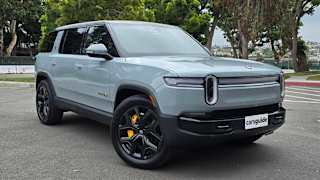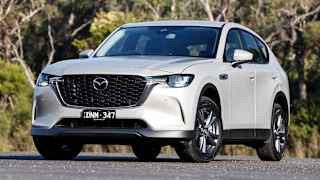First, the less-good. The minimalist and button-free interior will be a major downside for many. Pretty much everything in the ID.5’s cabin is touch-based. There’s not even a stop/start button, you just sit in the car and it’s ready to go. Additionally, it relies on the now-maligned touch sliders below the multimedia screen for volume and temperature adjustment. Never fun to use on the move. Even the buttons on the steering wheel are the touch-based haptic-feedback kind.
At least the software shapes up. It’s easy enough to navigate, and has a slew of straightforward menus. It’s also backed by enough processing power, with swift responsiveness, and the panel quality is good too, with a sharp, high-resolution finish.
This can be a double-edged sword, though. The high-resolution leads to small shortcut icons across the top of the main screen. While I’m glad the ID.5 has these so you can swap between things like the car’s settings menu and, say, Apple CarPlay easily, it takes some accuracy to jab at while you’re trying to drive.
From there, though, the cabin is clever. Free from the trappings of buttons and a raised console, it feels spacious in every dimension and the seat comfort is excellent with lovely side bolstering and padding.
The seats feel quality, but I wonder whether the synthetic suede-style microfleece trim will age as well or be as easy to clean as cloth or leather. Worth thinking about if you plan to keep this car for a long time.
I even like the touch of having little flip-down armrests which almost makes it feel like you’re being silently propelled along in an armchair in the front seats.
You need these because there’s no traditional raised console with an armrest box. Instead there’s a flexible floating central console piece. It features a modular sort of design, where you can make use of either dividers or a drop-in bottle holder piece in either the upper or lower sections, depending on your preference. Remove these things entirely to have two massive trays.
Meanwhile, the lower section features a cubby with a wireless phone charger, and it also houses the dual USB-C ports with a sliding cover so you can keep the interior tidy. I like it.
There are large bottle holders in the doors, too, and another nice touch is the digital dash being perched on the steering column, so no matter how you adjust it, you can always see it.
The back seat is also excellent in the ID.4 and ID.5, featuring plenty of space for me behind my own driving position, at 182cm tall. There’s heaps of airspace for my knees, and because there’s a flat floor courtesy of this car’s dedicated 'MEB' platform, there’s plenty of space for your feet. It also makes the centre position usable by an adult, which is rare.
Soft trims continue in the doors, but my favourite feature of the ID.5’s rear bench is how the brand has thought to strongly contour the outer two seat backings so even they have plenty of side bolstering.
The backs of the front seats feature an upper pocket for phones and the like, and a larger lower pocket, while the doors feature a large bottle holder each. A drop-down armrest has three shaped cavities for bottles of all sizes, and behind it is a ski port door.
There are adjustable air vents and a touch panel to control the rear climate zone, but because of the low design of the central console, they’re basically on the floor. Nice to have them, but they might be hard to adjust for kids or the less mobile.
This will surprise you. The boot is bigger in the ID.5 than in the ID.4 despite this car’s descending roofline. Measuring 549 litres, it’s also good for the mid-size segment and features an under-floor storage area which is great for your charging equipment. However, there is no spare wheel, just an inflator kit, and also, the ID.5 doesn’t get a frunk like many of its electric contemporaries.







